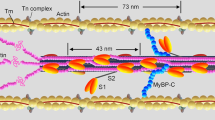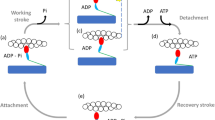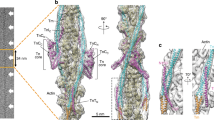Abstract
Muscle force is generated by myosin crossbridges interacting with actin. As estimated from stiffness1,2 and equatorial X-ray diffraction3 of muscle and muscle fibres, most myosin crossbridges are attached to actin during isometric contraction, but a much smaller fraction is bound stereospecifically4,5,6,7. To determine the fraction of crossbridges contributing to tension and the structural changes that attached crossbridges undergo when generating force, we monitored the X-ray diffraction pattern during temperature-induced tension rise in fully activated permeabilized frog muscle fibres. Temperature jumps8 from 5–6 °C to 16–19 °C initiated a 1.7-fold increase in tension without significantly changing fibre stiffness or the intensities of the (1,1) equatorial and (14.5 nm)−1 meridional X-ray reflections. However, tension rise was accompanied by a 20% decrease in the intensity of the (1,0) equatorial reflection and an increase in the intensity of the first actin layer line by ∼13% of that in rigor. Our results show that muscle force is associated with a transition of the crossbridges from a state in which they are nonspecifically attached to actin to one in which stereospecifically bound myosin crossbridges label the actin helix.
This is a preview of subscription content, access via your institution
Access options
Subscribe to this journal
Receive 51 print issues and online access
$199.00 per year
only $3.90 per issue
Buy this article
- Purchase on Springer Link
- Instant access to full article PDF
Prices may be subject to local taxes which are calculated during checkout




Similar content being viewed by others
References
Goldman, Y. E. & Simmons, R. M. Active and rigor muscle stiffness. J. Physiol., Lond. 269, 55P–57P (1977).
Higuchi, H., Yanagida, T. & Goldman, Y. E. Compliance of thin filaments in skinned fibers of rabbit skeletal muscle. Biophys. J. 69, 1000–1010 (1995).
Haselgrove, J. C. & Huxley, H. E. X-ray evidence for radial cross-bridge movement and for the sliding filament model in actively contracting skeletal muscle. J. Mol. Biol. 77, 549–568 (1973).
Huxley, H. E., Faruqi, A. R., Kress, M., Bordas, J. & Koch, M. H. J. Time resolved X-ray diffraction studies of the myosin layer line reflections during muscle contraction. J. Mol. Biol. 158, 637–684 (1982).
Yagi, N. Intensification of the first actin layer-line during contraction of frog skeletal muscle. Adv. Biophys. 27, 35–43 (1991).
Amemiya, Y., Wakabayashi, K., Tanaka, H., Ueno, Y. & Miyahara, J. Laser-stimualted luminescence used to measure x-ray diffraction of a contracting striated muscle. Science 237, 164–168 (1987).
Bordas, J. et al. Two-dimensional X-ray diffraction of muscle: recent results. Adv. Biophys. 27, 15–33 (1991).
Bershitsky, S. Y. & Tsaturyan, A. K. Force generation and work production by covalently cross-linked actin-myosin cross-bridges in rabbit muscle fibers. Biophys. J. 69, 1011–1021 (1995).
Huxley, H. E. The mechanism of muscular contraction. Science 164, 1356–1366 (1969).
Huxley, A. F. & Simmons, R. M. Proposed mechanism of force generation in striated muscle. Nature 233, 533–538 (1971).
Huxley, H. E. & Kress, M. Cross-bridge behaviour during muscle contraction. J. Musc. Res. Cell Motility 6, 153–161 (1985).
Hirose, K., Lenart, T. D., Murray, J. M., Franzini-Armstrong, C. & Goldman, Y. E. Flash and smash: rapid freezing of muscle fibers activated by photolysis of caged ATP. Biophys. J. 65, 397–408 (1993).
Ling, N., Shrimpton, C., Sleep, J., Kendrick-Jones, J. & Irving, M. Fluorescent probes of orientation of myosin regulatory light chains in relaxed, rigor and contracting muscle. Biophys. J. 70, 1836–1846 (1996).
Ostap, E. M., Barnett, V. A. & Thomas, D. D. Resolution of three structural states of spin-labelled myosin in contracting muscle. Biophys. J. 69, 177–188 (1995).
Kress, M., Huxley, H. E., Faruqi, A. R. & Hendrix, J. Structural changes during activation of frog muscle studied by time-resolved X-ray diffraction. J. Mol. Biol. 188, 325–342 (1986).
Ford, L. E., Huxley, A. F. & Simmons, R. M. Tension responses to sudden length change in stimulated frog muscle fibres near slack length. J. Physiol., Lond. 269, 441–515 (1977).
Huxley, H. E. et al. Changes in the X-ray reflections from contracting muscle during rapid mechanical transients and their structural implications. J. Mol. Biol. 169, 469–506 (1983).
Irving, M., Lombardi, V., Piazzesi, G. & Ferenczi, M. A. Myosin head movements are synchronous with the elementary force-generating process in muscle. Nature 357, 156–158 (1992).
Lombardi, V., Piazzesi, G., Ferenczi, M. A., Thirlwell, H. & Irving, M. Elastic distortion of myosin heads and repriming of the working stroke in muscle. Nature 374, 553–555 (1995).
Piazzesi, G. et al. Changes in the x-ray diffraction pattern from single, intact muscle fibers produced by rapid shortening and stretch. Biophys. J. 68, 92s–98s (1995).
Bershitsky, S. Y. et al. Mechanical and structural properties underlying contraction of skeletal muscle fibers after partial 1-ethyl-[3-(3-dimethylamino)propyl]carbodiimide cross-linking. Biophys. J. 71, 1462–1474 (1996).
Vainstain, B. K. Diffraction of X-rays by Chain Molecules (Izdatelstvo Akademii Nauk SSSR, Moscow, (1963)).
Cooke, R., Crowder, M. S., Wendt, C. H., Barnett, V. A. & Thomas, D. D. in Contractile Mechanisms in Muscle 413–423 (Plenum, New York, London, (1984)).
Harford, J. J. & Squire, J. M. Evidence for structurally different attached states of myosin cross-bridges on actin during contraction of fish muscle. Biophys. J. 63, 387–396 (1992).
Brenner, B. & Yu, L. C. Structural changes in the actomyosin cross-bridges associated with force generation. Proc. Natl Acad. Sci. USA 90, 5252–5256 (1993).
Irving, M. et al. Tilting of the light-chain region of myosin during step length changes and active force generation in skeletal muscle. Nature 375, 688–691 (1995).
Martin-Fernandez, M. A. et al. Time-resolved X-ray diffraction studies of myosin head movements in live frog sartorius muscle during isometric and isotonic contractions. J. Musc. Res. Cell Motility 15, 319–348 (1994).
Towns-Andrews, E. et al. Time-resolved x-ray diffraction station: x-ray optics, detectors and data acquisition. Rev. Scient. Instr. 60, 2346–2349 (1989).
Huxley, H. E. & Brown, W. The low-angle X-ray diagram of vertebrate striated muscle and its behaviour during contraction and rigor. J. Mol. Biol. 30, 383–434 (1967).
Acknowledgements
We thank M. Irving for comments on the early version of the manuscript, D. R. Trentham for support, and E. Towns-Andrews and the non-crystalline-diffraction team at CLRC Daresbury Laboratory for hard- and sofware support. The work was supported by the MRC and grants from the EU, INTAS, ISF, HHMI, RFBR and by CCP13 of EPSRC and BBSRC.
Author information
Authors and Affiliations
Corresponding author
Rights and permissions
About this article
Cite this article
Bershitsky, S., Tsaturyan, A., Bershitskaya, O. et al. Muscle force is generated by myosin heads stereospecifically attached to actin. Nature 388, 186–190 (1997). https://doi.org/10.1038/40651
Received:
Accepted:
Issue Date:
DOI: https://doi.org/10.1038/40651
This article is cited by
-
The force of the myosin motor sets cooperativity in thin filament activation of skeletal muscles
Communications Biology (2022)
-
Regulation of the evolutionarily conserved muscle myofibrillar matrix by cell type dependent and independent mechanisms
Nature Communications (2022)
-
Two-boundary first exit time of Gauss-Markov processes for stochastic modeling of acto-myosin dynamics
Journal of Mathematical Biology (2017)
-
Stiffness, working stroke, and force of single-myosin molecules in skeletal muscle: elucidation of these mechanical properties via nonlinear elasticity evaluation
Cellular and Molecular Life Sciences (2013)
-
Stiffness and number of crossbridges attached in active frog muscle: a reply to Professor Lombardi
Journal of Muscle Research and Cell Motility (2011)
Comments
By submitting a comment you agree to abide by our Terms and Community Guidelines. If you find something abusive or that does not comply with our terms or guidelines please flag it as inappropriate.



